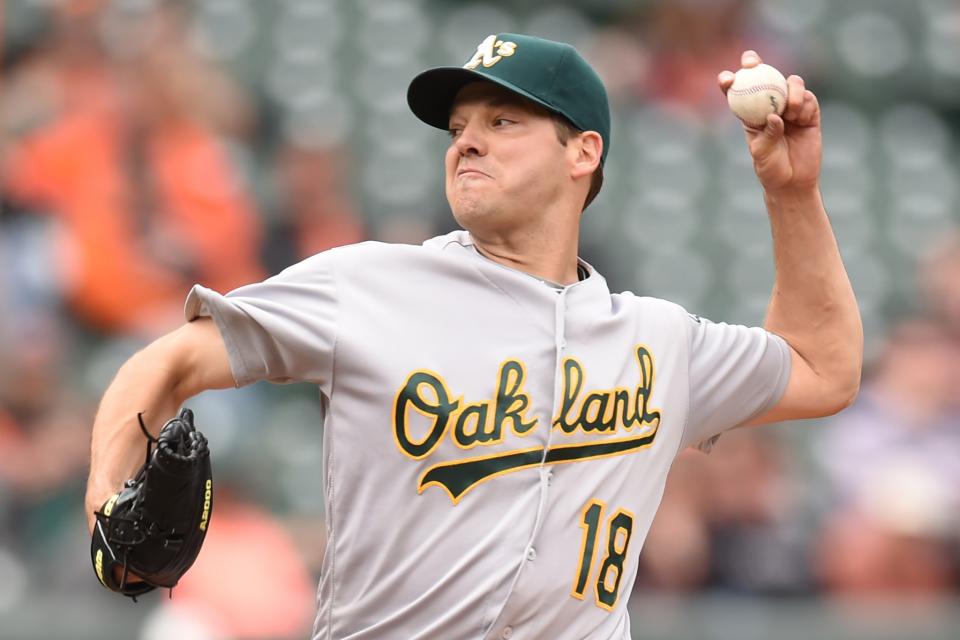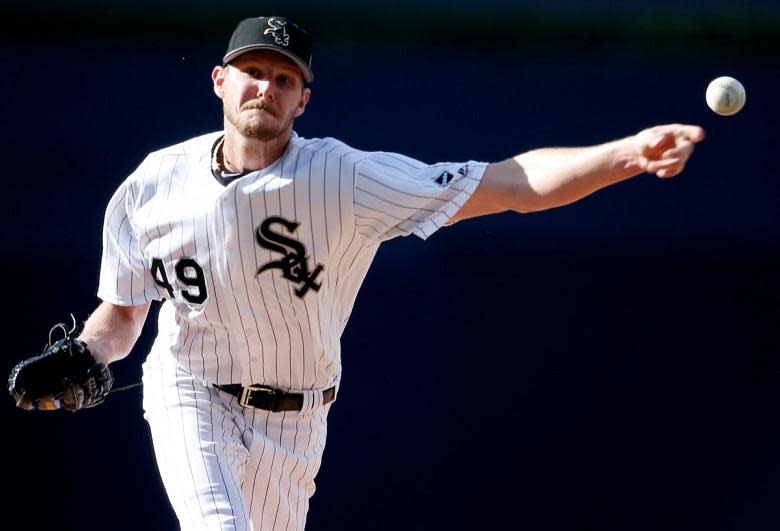The latest news and notes for MLB's trade deadline

The systematic deconstruction of a Major League Baseball team to a bare-bones payroll is nearly complete, and no one seems to notice. The San Diego Padres are shedding money so quickly that they owe more in 2017 to players who aren’t on their roster than those who currently play for them. Considering that in the neighborhood of $100 million in shared money is funneled annually to low-revenue teams like San Diego, a complete rebuild isn’t just a good narrative to spin for long-term success. It’s great for business.
Never was the Padres’ desire to shed payroll more evident than in their trade of Melvin Upton Jr. to the Toronto Blue Jays. While the prospect they received, Hansel Rodriguez, has hit 98 mph with his fastball this year, he’s a 19-year-old in rookie ball. The chance he ever contributes in the major leagues is tiny. Which gives the Padres only the money they saved on a year and two months of Upton: $5 million. Even if Upton is terrible – and he hasn’t been since he joined San Diego – a $5 million outlay is a plenty reasonable investment.
Just not for a team that wants to burn its big league payroll to the ground. The Padres started the season with a $99.2 million roster. They may be at half that before next season, and it would be the lowest in years.
Over the next few days, San Diego will trade Andrew Cashner and his $7.15 million salary. The Padres have pushed catcher Derek Norris on anyone who will ask. Were Tyson Ross not hurt, he’d have been a goner, and if he returns and pitches well, he’ll be exceedingly popular on the winter trade market. Everybody else making more than $1 million on the Padres either is a pending free agent (Jon Jay, Matt Thornton, Carlos Villanueva), easily bought out of a 2017 option (Alexei Ramirez) or Matt Kemp.
Kemp’s is the only contract on the Padres’ books for 2017, and it is ugly: $21.75 million, only $3.75 million of which is being paid down by the Dodgers. Same numbers go for 2018 and 2019, too. Kemp’s deal is a reminder of the Padres’ ill-fated attempt at relevancy and success in 2015 that ended with the team looking more like Three Mile Island than Coronado.
The 23 home runs and .488 slugging percentage make Kemp seem reasonably productive; the truth: His money is, at this point, every bit as dead as the $22.45 million they’re playing the White Sox and Blue Jays for James Shields and Upton. Kemp’s .281 on-base percentage is 157th of 161 players who have qualified for the batting title. It’s not the worst on the Padres, of course, and not the second worst, either, which says all you need to know about the Padres.
Kemp’s defense and baserunning make the money owed him look even worse, and the scary part is he could account for nearly 40 percent of the Padres’ meager payroll next year if they follow the pattern of previous rebuilders and shed all they can. Even if Ross sticks around next season, the Padres are staring at reasonable arbitration raises for Wil Myers, Yangervis Solarte, Brandon Maurer, Jemile Weeks, Brad Hand and Christian Friedrich. Provided they stay quiet in free agency, their active roster’s payroll could dip under $50 million.
Nothing keeps them from doing this, and a rebuilt minor league system has the fruits of general manager A.J. Preller’s trades with Boston (Anderson Espinoza and Manny Margot, chiefly) along with outfielder Hunter Renfroe, catcher Austin Hedges and a loaded class of young Latin American players, including Cubans Adrian Morejon and Jorge Ona.
Certainly some of the money saved is going to international players. Morejon received $11 million to sign and Ona $7 million. The Padres spent another $10 million on top prospects from the Dominican Republic and Venezuela this month. Double those costs – teams that break their international pool limit pay a dollar-for-dollar tax – and it’s approaching $60 million on teenagers alone.
It’s risky, but then again Preller built the Rangers’ international system that spit out Rougned Odor, Nomar Mazara and Jurickson Profar, so this is his bailiwick. It just means desperate times for the big-league club. Travis Jankowski could be a good OBP-and-D center fielder, and maybe Alex Dickerson’s hitting ability translates to the big leagues, and perhaps Ryan Schimpf is more than a six-year free agent who happened to catch fire for a month.
Even if all three hit, the Padres will go down before they go up. That’s what happens when you dip to Astros/Marlins levels and sell almost all cultivated assets. The payroll, such a point of pride in 2014, will return to the sort of embarrassing levels not seen in half a decade, and the Padres, like every other team, will say it’s just smart business.

The starting pitching market is frozen for the moment, according to executives with buyers, because sellers are asking too much. The starting pitching market is frozen for the moment, according to executives with sellers, because buyers don’t understand the market favors the teams with assets. Thus, the current stalemate in which Cashner, Rich Hill, Jeremy Hellickson, Edinson Volquez, Ervin Santana, James Shields and Wade Miley remain with their teams.
The young-and-under-control crowd – Jake Odorizzi, Matt Moore, Chris Archer, Shelby Miller, Anthony DeSclafani, Hector Santiago and Matt Shoemaker among them – is simply unattainable at current prices, which include top prospects and major league position players, according to sources. It’s almost as rough for rentals like Cashner, Hill, Hellickson and Volquez: Most offers from sellers, executives said, include multiple prospects or one top-level prospect.
Soon enough, teams will stop holding the big hauls of the Drew Pomeranz and Aroldis Chapman trades as the standard of this market, and the thaw should lead to a slew of deals closer to the deadline.
Hill is a particularly interesting case because of the blister on his middle finger that has caused him to miss starts and taunted Oakland. The fear of injuries from contenders looking to deal for him is palpable, but each recognizes how well Hill has pitched when he has been healthy. The answer is: Well enough that if teams are scared off by the blister and don’t offer commensurate value, the A’s would lean toward tendering him a qualifying offer this offseason to either retain him (on a one-year deal that ESPN’s Buster Olney said will near $17 million) or extract a draft pick. Hill plans on pitching Sunday.

Based on the packages White Sox general manager Rick Hahn is asking for Chris Sale, the chances of a deal between now and Aug. 1 at 4 p.m. ET are somewhere between 0 percent and 0 percent. Depending on the team, proposed deals have ranged from four to six players, according to league sources, and included All-Stars, young players with long-term deals and top prospects.
Considering the White Sox don’t have to trade Sale, this is the proper tack: Get blown away. Chicago is spreading a wide net, not just focusing on teams with top prospects like the Dodgers (Julio Urias), Red Sox (Yoan Moncada or Andrew Benintendi), Nationals (Lucas Giolito or Trea Turner), Rangers (Nomar Mazara) and Astros (Alex Bregman). And with that open-mindedness come some blockbuster possibilities.
While this was pure speculation from an executive, it made some sense: a trade centered around Sale and Andrew McCutchen. Pittsburgh long has desired a top starter to stand alongside Gerrit Cole, and Sale is the perfect Pirate: great and cheap. He is owed $38 million over the next three years. McCutchen will make $28 million for the 2017-18 seasons, after which he hits free agency.
The idea of the Pirates trading their most iconic player in the past two decades is painful, the prospect of losing him to free agency is real, and they’ve got a ready-made prospect in Austin Meadows ready to take over. Among Gregory Polanco, Starling Marte, Jung-ho Kang, Josh Harrison, Francisco Cervelli, Josh Bell and Meadows, Pittsburgh has plenty of offense to withstand the loss of McCutchen.
Chicago, meanwhile, would be buying low on McCutchen, who has slumped this season, and could ask for the inclusion of pitching prospect Tyler Glasnow or Jameson Taillon to fortify Pittsburgh’s offer. While it temporarily weakens their rotation, a White Sox lineup anchored by McCutchen, alongside Jose Abreu, Todd Frazier, Adam Eaton and Tim Anderson, is rather imposing. Granted, improving the offense at the expense of a pitching staff that without Sale is even flimsier could be ill-advised, but Hahn said he wanted to try something different, and adding a former MVP to the lineup generally helps. It wouldn’t provide the volume to rebuild on the fly that Hahn is seeking. It would give the White Sox a chance to take one more crack at a run with a twist on this incarnation of a team.

Part of the Royals’ calculus in considering trades for Wade Davis – and the Royals still match up with the Washington Nationals, who can’t be comfortable with the idea of Jonathan Papelbon closing games in October, better than anyone – is the scariest number for anyone in Kansas City: 2017.
Nearly a quarter of the Royals’ roster, all vital, are due to hit free agency after next season: first baseman Eric Hosmer, third baseman Mike Moustakas, outfielder Lorenzo Cain, shortstop Alcides Escobar, starter Danny Duffy and Davis. And considering the mediocre 2016 from outfielder Alex Gordon and starter Ian Kennedy, the Royals’ two highest-paid players in 2018 and beyond, Kansas City’s maneuvering could make the difference between a rough and smooth transition to a new generation of players.
The prospect of Davis re-signing is minute; Kansas City can’t afford the $15 million-plus-a-year market Aroldis Chapman will set for closers this offseason, and two pennant runs for him is far more appealing to interested teams that understand bullpens can win World Series in the modern game.
Washington balked at the Royals’ request of Giolito, arguably the game’s best pitching prospect, and the Dodgers – whose interest in Davis was reported by FanRag’s Jon Heyman – would do the same with Urias. The Dodgers’ prospect depth is tremendous, though, and the idea of dealing outfielder Alex Verdugo, first baseman Cody Bellinger or pitcher Jose DeLeon as a centerpiece in a deal for Davis certainly isn’t farfetched.
* * *
On the surface, Atlanta’s acquisition of second base prospect Travis Demeritte for pitchers Dario Alvarez and Lucas Harrell was a win. Both were picked up for nothing in May and spun into a 21-year-old middle infielder with 25 home runs in 88 games.
Two caveats before Braves fans anoint Demeritte: He is playing in the Cal League, notorious for its altitude-aided home runs and, even more important, he strikes out a staggering amount. In 378 plate appearances this season, Demeritte has K’d 125 times. This is not a death sentence, but rare is the 21-year-old in A-ball punching out in 33 percent of his plate appearances who becomes a productive big leaguer.
Though Harrell is little more than an innings-eating arm, Alvarez is interesting. He has added nearly 3 mph on his fastball since last season while throwing it about half as much as he did. In its place is a slider that he throws at a higher rate than any pitcher in baseball, 61.4 percent of the time. It’s working. The 27-year-old left-hander is striking out 16.8 batters per nine innings, second in the big leagues among those with 15 innings pitched. For a thin Texas pitching staff, it’s a medium-risk gamble well worth taking.
More MLB coverage:


